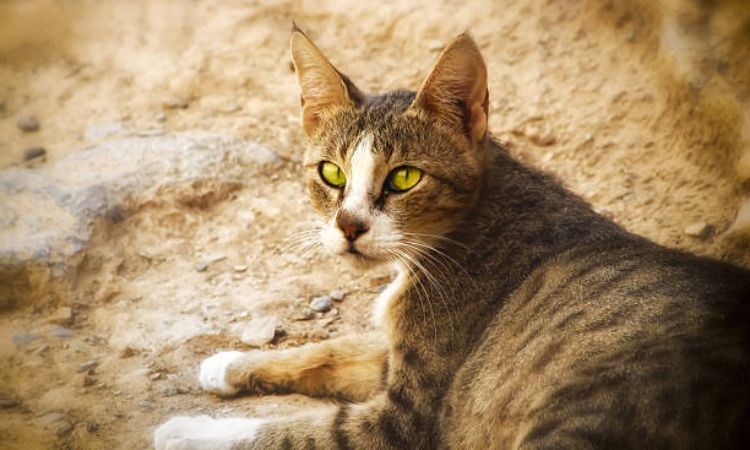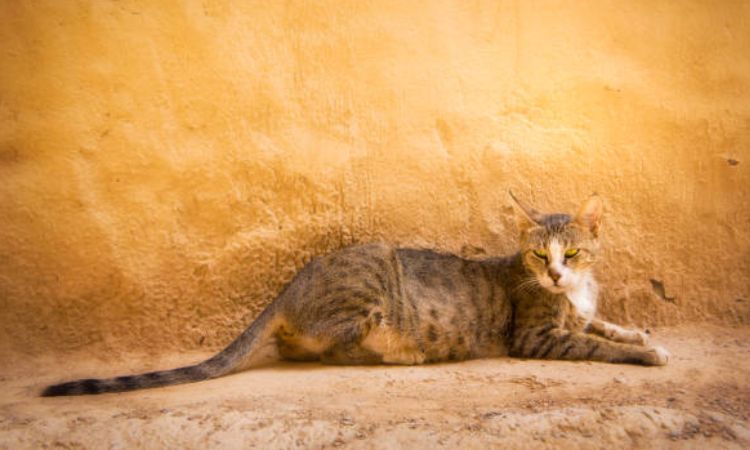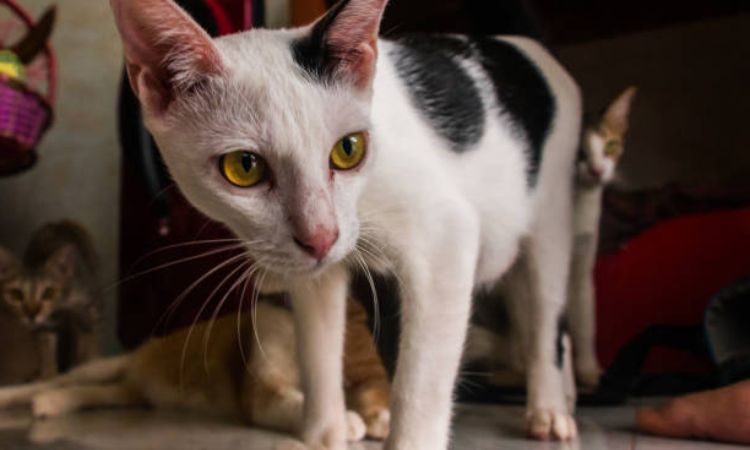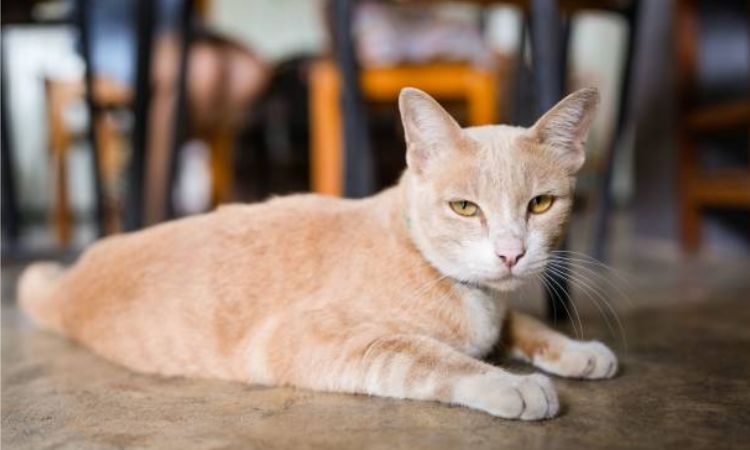With its sleek coat, expressive eyes, and boundless curiosity, the Arabian Mau is a captivating cat that has roamed the deserts of the Arabian Peninsula for centuries. Evolving naturally from early African wildcats, this resilient breed has adapted to harsh climates while developing a playful, affectionate personality that makes it a cherished companion today.
In this guide from Nexus Pets, we’ll explore everything you need to know about the Arabian Mau—its personality, size, striking color variations like orange, calico, and ginger, as well as pricing and kitten care tips.

The Origin and History of the Arabian Mau
The Arabian Mau is an ancient natural breed that developed over centuries in the deserts and streets of the Arabian Peninsula, including countries like Saudi Arabia, Kuwait, Qatar, Oman, and the United Arab Emirates. These cats adapted to harsh desert conditions, developing large ears for heat dissipation, a short coat without an undercoat, and a strong, muscular, and agile body. Originally feral, they hunted small prey and defended their territory with skill. As cities emerged, Arabian Maus moved closer to human settlements in search of food, gradually becoming domesticated while retaining their independent and intelligent nature.
Although the breed existed for over a thousand years, formal recognition and preservation came only in the 21st century. The World Cat Federation (WCF) officially recognized the Arabian Mau in 2008, marking the first breed acknowledgment by the organization in over a decade. This recognition established breed standards for size, body structure, coat, head shape, and temperament, ensuring the preservation of the Arabian Mau’s distinctive traits for future generations.
Often mistaken for the Egyptian Mau, the Arabian Mau is a distinct breed. Unlike the selectively bred Egyptian Mau, the Arabian Mau is a naturally occurring domestic short-haired landrace, with a variety of coat colors including tabby, bicolor, white, black, and red. Its characteristics reflect centuries of adaptation to desert life rather than human-directed breeding, making it a unique and resilient feline companion.
Physical Characteristics and Size
The Arabian Mau is a medium-to-large domestic cat, typically weighing between 8 and 16 pounds. Males are generally larger than females, with a more muscular and robust frame. Its body is athletic and well-balanced, reflecting a breed built for agility and endurance, traits inherited from its desert ancestry. Key physical traits include:
- Muscular, Athletic Build: Long, strong legs and oval-shaped paws provide exceptional jumping and running abilities, allowing the cat to move gracefully across various terrains.
- Distinctive Head Shape: Slightly rounded head, a bit longer than wide, with well-defined whisker pads and a firm chin.
- Large, Pointed Ears: Set high on the head and angled slightly outward, these ears help dissipate heat in the hot Arabian climate.
- Expressive Eyes: Slightly oval, commonly bright green, though other colors are possible.
- Short, Fine Coat: Lies close to the body and lacks an undercoat, keeping the cat cool in warm environments. Coat colors and patterns are diverse, including red, white, black, brown tabby, bicolor, and spotted combinations.
Personality, Temperament, and Social Needs
Arabian Maus are much more than just striking desert cats—they are devoted, intelligent, and lively companions with personalities that endear them to families around the world.
The Devoted and Affectionate Companion
Arabian Maus form strong bonds with their human families, often becoming deeply attached to specific individuals. They enjoy following their favorite people from room to room, observing daily activities, and being included in family interactions. Their loyalty and affectionate nature make them excellent companions, offering both emotional connection and playful companionship. While they crave attention, they are not clingy—they balance independence with devotion, showing affection on their own terms.
Energy and Playfulness
This breed is highly energetic and thrives on both mental and physical stimulation. Arabian Maus love to climb, jump, and explore, often seeking elevated perches such as shelves, cat trees, or window sills. They are intelligent hunters at heart, making interactive toys, puzzle feeders, and games of fetch excellent tools for keeping them engaged. Regular playtime not only satisfies their active nature but also prevents boredom and behavioral issues, especially if they are primarily indoor cats.

Vocalization and Communication
Arabian Maus are known for being “talkative.” They use a range of vocalizations—from high-pitched meows to chirps and trills—to communicate their needs, desires, and moods. Their voices often express excitement, curiosity, or the desire for interaction, making them highly expressive companions who are never shy about letting you know what they want.
Family and Pet Friendliness
Arabian Maus are generally friendly and adaptable in family settings. They typically get along well with children, enjoying playful interactions that match their energetic temperament. With other pets, they can also coexist peacefully, provided proper introductions and gradual socialization are implemented. As a territorial breed, careful management is necessary when introducing new cats, but with patience, they can share a household harmoniously.
Arabian Mau Colors and Patterns
The Arabian Mau is not only known for its lively personality and athletic build but also for its diverse and striking coat colors and patterns. As a naturally occurring breed developed in the deserts and cities of the Arabian Peninsula, the Arabian Mau’s coat reflects both its environment and its feral ancestry.
Coat Colors
Arabian Maus exhibit a variety of colors, each giving the cat a distinct and beautiful appearance. Common colors include:
- Red – Often seen in tabby patterns, this warm color highlights the cat’s agile body and expressive features.
- Black – Sleek and glossy, black Arabian Maus are striking and elegant.
- White – Frequently appearing as patches or bicolor combinations, white fur adds contrast to other colors.
- Brown Tabby – Brown tabby patterns are highly common, featuring stripes, spots, or marbling that emphasize their natural wildcat look.
- Ginger/Orange – Less common but highly sought after, ginger shades often display a rich, warm tone with subtle striping.
- Calico and Bicolor Combinations – Arabian Maus can have multi-colored coats, including combinations of red, black, and white in striking calico patterns.
Patterns
The breed’s markings can vary significantly, giving each cat a unique appearance:
- Spotted – Some Arabian Maus display small or large spots along their flanks and back, a trait reminiscent of their desert wildcat ancestors.
- Striped/Tabby – Tabby patterns are common, with classic, mackerel, or blotched striping enhancing their athletic frame.
- Bicolor – Patches of white combined with any other color, creating visually striking contrast.
- Mixed Patterns – Some cats exhibit a combination of stripes, spots, and white patches, making them particularly distinctive.
Coat Texture
The Arabian Mau’s fur is short and lies close to the body, allowing it to remain sleek and streamlined. Unlike many other breeds, it has no undercoat, which is an adaptation to hot climates and reduces shedding. This coat type also makes grooming easy, requiring only occasional brushing to remove loose hairs and maintain a healthy shine.

Eye and Coat Color Relation
While Arabian Maus often have bright green or yellow eyes, there is no strict correlation between coat and eye color. Each cat’s combination of eye and fur color is unique, further adding to the breed’s individual charm.
Arabian Mau Kittens: What to Know Before You Adopt
Energetic and Curious Kittens
Arabian Mau kittens are full of energy, curiosity, and charm. From the moment they’re born, they’re ready to explore, climb, and discover their surroundings. This breed’s playful nature is rooted in their history as agile desert hunters, and their kittenhood is marked by an eagerness to jump, run, and engage in interactive play. Expect your Arabian Mau kitten to be energetic, lively, and always on the move. Their playful behavior is paired with sharp intelligence, and they’re quick to learn new things—whether it’s a game or a trick.
As kittens, they’re highly curious about the world around them, and they’ll want to explore every corner of your home. It’s important to give them safe spaces to roam and plenty of engaging toys and activities to keep their minds and bodies active. If you have other pets, they may naturally try to interact with them, as the Arabian Mau is known for its social behavior, though it’s important to introduce them gradually.
Socialization is Key
Socialization plays a crucial role in shaping your Arabian Mau kitten’s temperament. Early handling and exposure to various people, sounds, and environments will help them grow into confident and well-adjusted adults. While the Arabian Mau is generally an affectionate breed, kittens that aren’t properly socialized may become shy, fearful, or overly territorial as they grow.
- Handling: Gently handle your kitten from an early age. Allow them to get used to being held, petted, and groomed. This not only helps them become comfortable with humans but also fosters a strong bond between you and your kitten.
- Exposing to New Environments and Sounds: Gradually introduce your kitten to new environments within your home and various sounds like the vacuum, doorbells, or kitchen appliances. This helps them become more adaptable and less anxious in different situations.
- Introducing Other Pets: If you have other pets, introduce them carefully. Start by allowing them to see each other from a safe distance, and then proceed with supervised face-to-face meetings. Slowly increase the time they spend together to ensure a peaceful coexistence. Proper introductions help avoid territorial issues and minimize stress for your new kitten.

Essential Training
Arabian Mau kittens are highly intelligent and eager to learn, making training relatively easy—if you start early. Establishing good habits and training from a young age will help your kitten grow into a well-behaved adult cat.
- Litter Box Training: Most Arabian Mau kittens will naturally gravitate to the litter box, as their instinct is to bury waste. Show them the box immediately when they arrive home, and place them in it after meals or naps to help them form good habits. Make sure the box is kept clean and accessible to encourage consistent use.
- Leash Training (if desired): Arabian Mau kittens love to climb and explore, and if you plan on leash training them, start early. First, get them used to wearing a harness for short periods, and then attach a leash once they’re comfortable. Start with short, safe sessions in an enclosed space like your living room or a secure yard. Gradually increase the duration and scope of the walks, using positive reinforcement to reward their progress.
- Territorial Behaviors: While Arabian Mau kittens are typically friendly, they are naturally territorial. If you plan to introduce new pets or have other animals in your home, ensure you introduce them slowly. Give each pet their own space and resources, like separate feeding areas and sleeping spots, to reduce competition. Early intervention with positive reinforcement can help prevent aggressive behavior as they grow.
Adopting an Arabian Mau kitten can be an incredibly rewarding experience. These energetic, affectionate, and intelligent kittens make excellent companions for families and individuals alike. With early socialization, proper training, and a stimulating environment, your Arabian Mau kitten will grow into a well-rounded, loving adult cat that will bring joy and excitement into your life.






